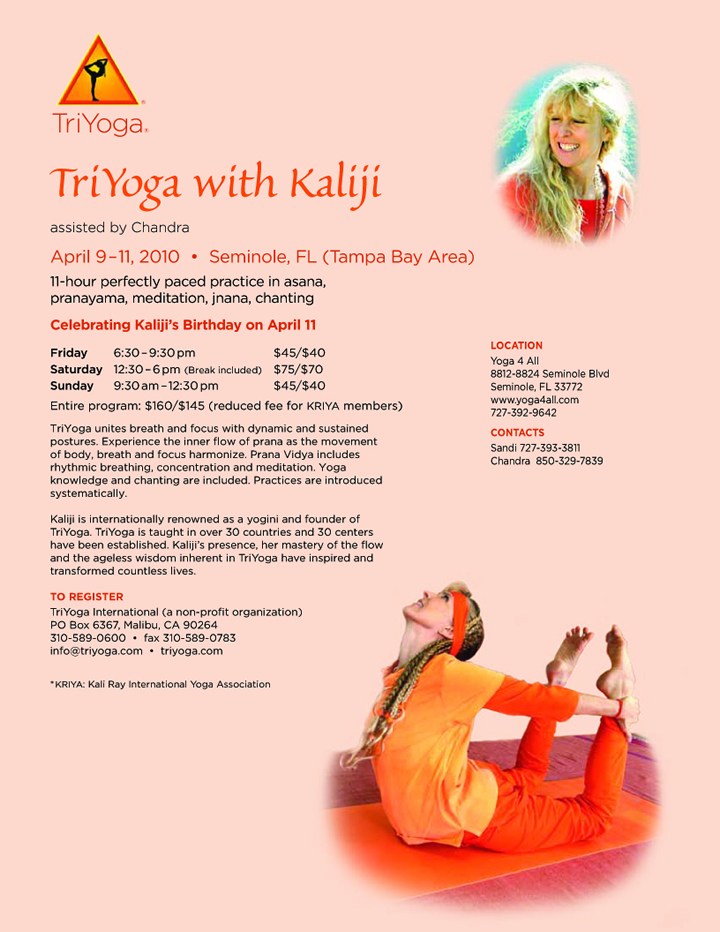Discover 15 tips to Holiday Eating without weight gain or dieting
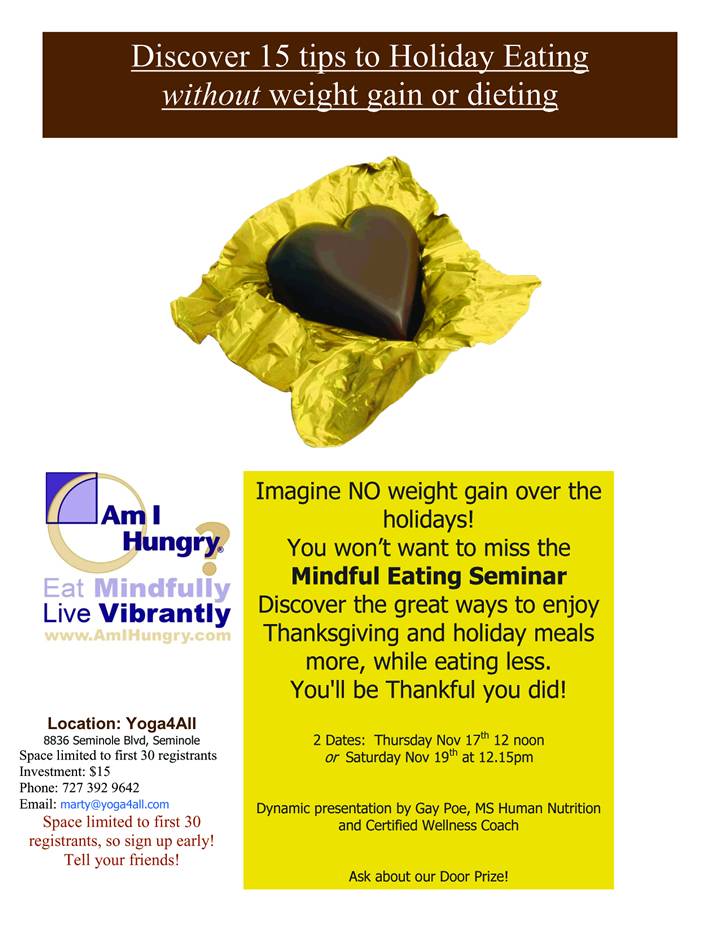
Why Try Meditation
By Judy Kovatch, eRYT, Certified Hypnotist
What is convenient, cost-effective, has no side effects and helps prevent heart disease? Many physicians now prescribe a daily dose of meditation. A growing body of scientific evidence confirms this ancient practice is good for the heart as well as the mind. Mainstream American medical journals have even published articles stating meditation can reduce the risk factors of heart disease.
Some people think meditation is an exotic, eccentric activity. In fact, meditation is completely normal. It is the mindful quality present in everything we do. Meditation is looking inward, looking at what we really have and discovering the richness that already exists.
The Beatles popularized a style of meditation, Transcendental Meditation, in the 1970’s. In the past 30 years, over 500 studies worldwide have investigated the effect of Transcendental Meditation (TM) on human beings. Conducted by 210 different universities and research institutions in 27 countries the articles have appeared in over 100 scientific journals.
These studies reveal meditation can help increase intelligence, improve memory, reduce chronic pain and promote cardiovascular health.
A study supported by a grant of the National Heart, Lung and Blood Institute shows that the stress reduction achieved through Transcendental Meditation may reduce atherosclerosis (hardening of the arteries) and the risk of heart attack and stroke. The findings were published in the March 2000 issue of the American Heart Association journal Stroke.
According to the research team from UCLA and Charles R. Drew University of Medicine and Science in Los Angeles, this is the first controlled study to suggest that stress reduction by itself can reduce the amount of fatty deposits in the arteries without changes in diet and exercise.
"The finding that the disease process in the arteries can be reduced though the TM program may have vast implications for the current management of cardio-vascular disease and health care costs" says Amparo Castillo-Richmond, M.D., lead author of the study.
In 1996 the American Heart Association journal Hypertension published the results of another study, which showed TM was effective in reducing blood pressure in people with high levels of stress and multiple risk factors for high blood pressure.
At the time the article was published, the AHA press release recommended, "People with high blood pressure may want to medicate and meditate." AHA spokesman, cardiologist Dr. Richard Stein adds that people whose blood pressure is just beginning to rise into the danger zone might be able to avoid going on medication by practicing TM. "That’s good news for people who can’t tolerate side effects, like drowsiness that come with some medications. There’s no downside to relaxation techniques."
The National Institute of Health thinks the TM findings are interesting enough to merit a grant of 7.5 million dollars.
What exactly is Meditation?
Based in the desire of discovering who and what we are, meditation practice falls into two basic categories:
1. Transcendental Meditation (TM) is also known as "One-pointed" meditation
In the TM method, attention is focused on one thing. Anything else that comes into the mind is seen as a distraction to be ignored. This practice gives rise to deep states of calmness and control of awareness. The practice of TM requires no adherence to any religious philosophy. It’s simple, requires no special equipment and doesn’t consume a lot of time.
Twice a day TM practitioners find a quiet place, sit comfortably and focus their minds on a single word or mantra (a special sound or phrase repeated silently to yourself). For 15 to 20 minutes, they enter a state of conscious relaxation often described as "restful alertness". An example of a mantra would be repeating the words "I am peace….I am peace….I have always been peace… Peace is all that exists."
Details about the scientific studies and the TM practice can be found at the official TM website www.tm.org.
2. Mindfulness Meditation
Mindfulness meditation, known as contemplation or insight meditation is the other major classification of meditation. Mindfulness begins by using the "one-pointed" approach to cultivate inner calmness and strength. It then moves on to a wider scope of self-examination. When thoughts or feelings come up they’re not ignored or suppressed, nor are they judged or analyzed. You simply note and observe them moment-by-moment.
You sit quietly with eyes fully open, half open or slightly open. Some variations call for a special attention to the breathing process, which helps deepen the concentration.
For more information about this type of meditation, you can read How to Meditate an article by Sakyong Mipham Rinpoche available online at www.shambhala.org.
All meditation training will be variations of the two basic categories. Meditation may be taught alone or in conjunction with yoga or martial arts programs. There are many meditation methods and classes available, so it’s best to shop around and seek out the one that’s right for you. For a free online meditation course check out Natural Meditation Initiatives. They present meditation in a culturally neutral format and offer a free self-paced Internet course in meditation. http://natural-meditation.org/
Some points to consider:
- Meditation is an escape to reality, not from reality. Avoid any guru or group that asks you to deny truth.
- Avoid complicated philosophies that require strict absolute rules of behavior
- You don’t need a special diet or fasting or celibacy to meditate properly.
- Don’t make meditation a competition with yourself or others
- Don’t limit yourself to just one teacher. Use teachers as a temporary tool based on science and fact, not on myth and tradition.
- Be patient, persistent and kind to yourself. Meditation takes practice and attention. At first you’ll find it hard to quiet your mind and turn off the inner voice I call "The Babbler".
The author, Judy Kovatch, RYT has 25 years experience with yoga and meditation. Educated in yoga at the Kripalu Center for Yoga and Health in Lenox MA, Judy is a certified teacher of Integrative Yoga Therapy, a program that views yoga as means to achieve total wellness of body, mind and spirit.
Sources:
American Heart Association
Maharishi University of Management Press Release March 3, 2000 regarding the article in the AHA journal Stroke
Official TM website
Stress Reduction Clinic UMMC
Project Need Food Drive
Project Need Food Drive
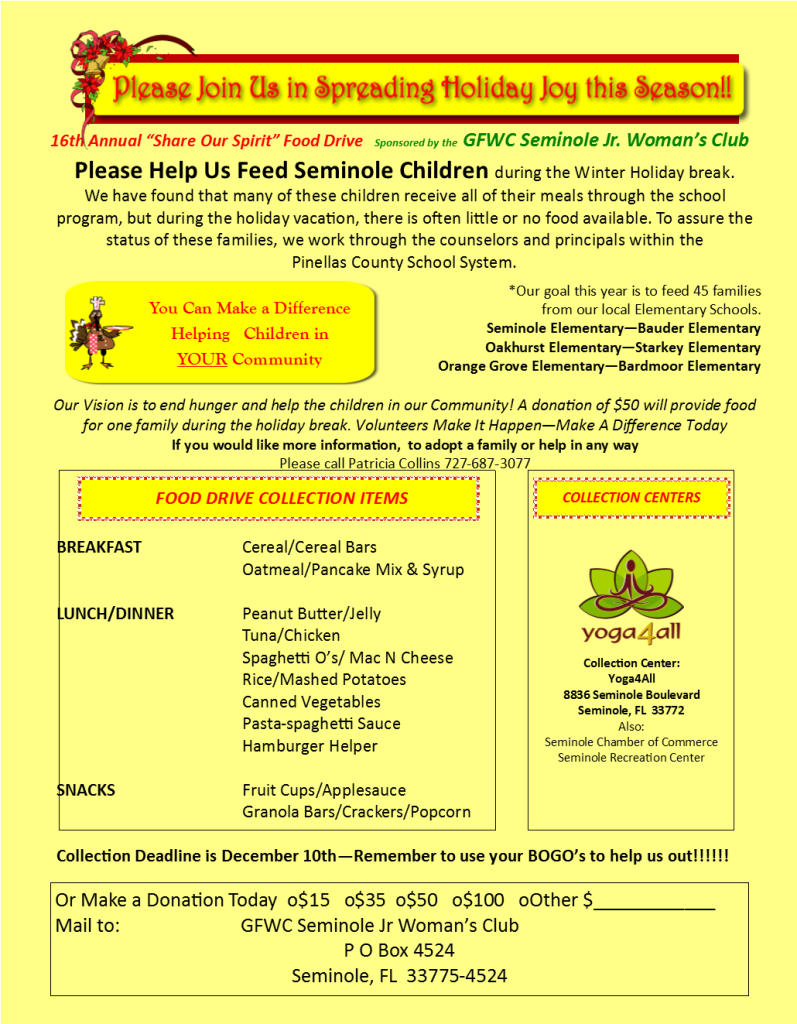
PLEASE HELP feed Seminole children during the winter holiday break. Many of these children receive all of their meals through the school program, but during the holiday vacation, there is often little or no food available. To assure the status of these families, the GFWC Seminole Jr. Woman’s Club works through the counselors and principals within the Pinellas County School System. Their goal this year is to feed 43 families from local Elementary Schools: Seminole Elementary, Bauder elementary, Oakhurst Elementary, Starkey Elementary, Orange Grove Elementary & Fugitt Elementary.
Suggested items, but all donations are appreciated:
Cereal/Cereal Bars
Oatmeal/ Pancake Mix & Syrup
LUNCH
Peanut Butter/Jelly
Tuna/Chicken
Spaghetti O’s/Mac N Cheese
Rice/Mashed Potatoes
Canned Vegetables
Pasta/Spaghetti Sauce
Hamburger Helper
SNACKS
Fruit Cups/applesauce
Granola Bars/Crackers/Popcorn
Or
Make a Donation
GFWC Seminole Jr. Woman’s Club
P O Box 4524
Seminole, FL 33775
Prenatal Yoga
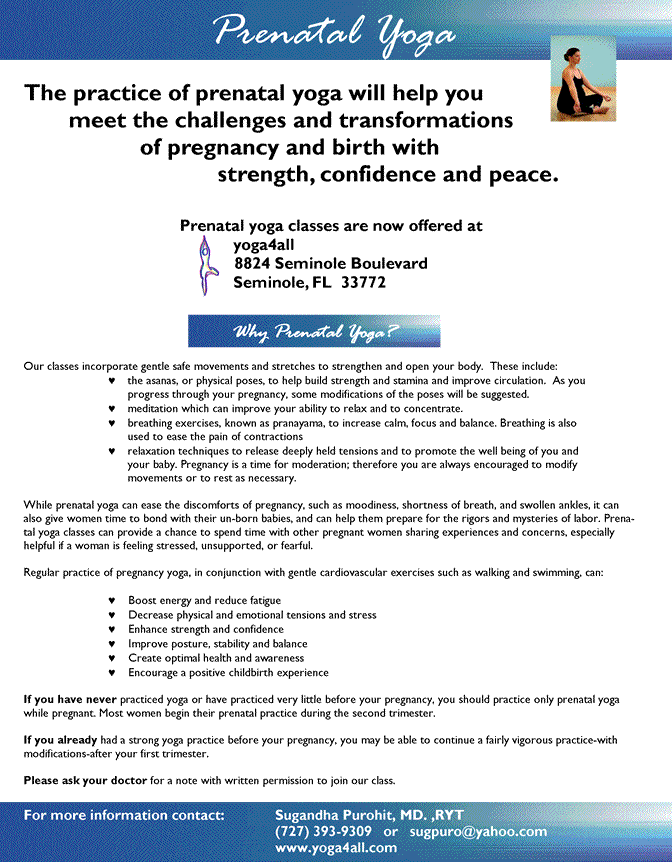
Road to Inversions
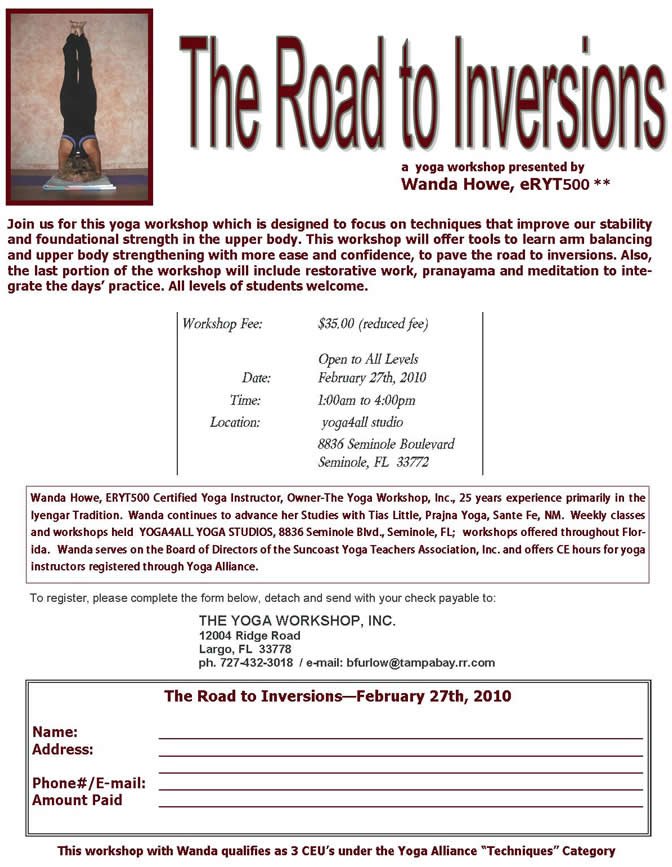
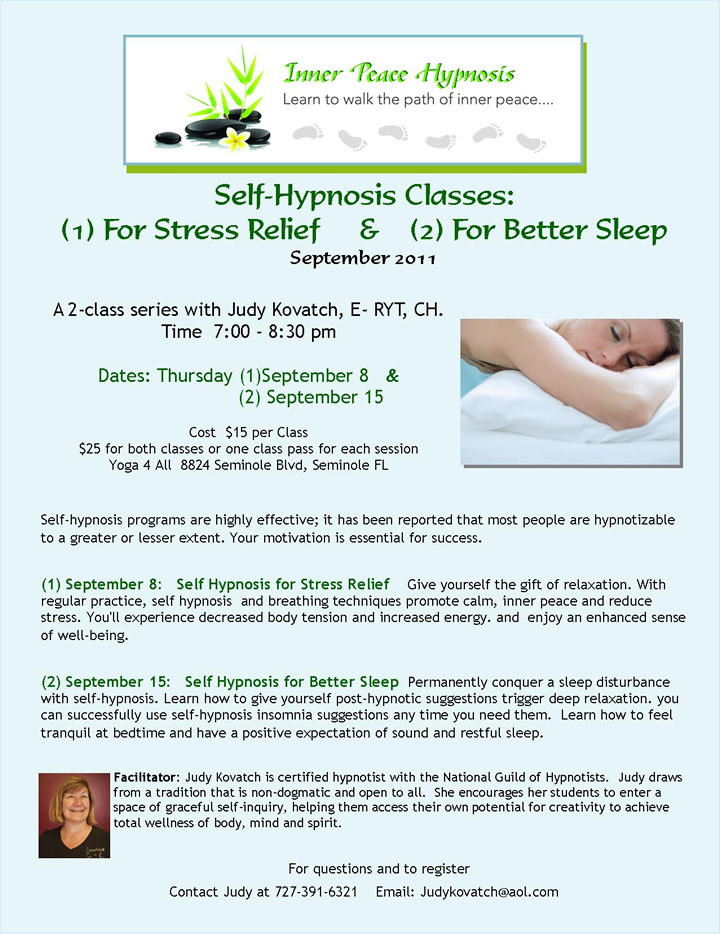
Health Secret Doctors Don’t Know
or
* how to reap the remarkable healing benefits of yoga *
by Timothy McCall, MD, a board-certified internist and medical editor of Yoga Journal.
Yoga is one of the most under-utilized and under-rated medical therapies in the US. It’s extremely rare for American medical doctors to prescribe yoga – most are not knowledgeable about its wide array of health benefits.
What You May Not Know
More than 100 scientific studies show that yoga can improve health problems ranging from heart disease to insomnia…diabetes to arthritis…cancer to bronchitis.
I’m a medical doctor who has practiced yoga for 12 years, and yoga is the most powerful system of health and well-being I have ever seen. By promoting overall health, yoga increases the benefits you may derive from conventional and/or alternative therapies – and may even eliminate your need for medication.
How Yoga Helps
Studies show that virtually all health problems respond positively to yoga. When 2,700 people suffering from a variety of ailments practiced yoga (for at least 2 hours a week for 1 year or longer), it helped 96% of those with back disorders…94% of those with heart disease…90% of those with cancer…90% of those with arthritis…88% of those with bronchitis or asthma…and 86% of those with diabetes.
What’s responsible for these salutary effects? Yoga, which is practiced by children as well as adults well into their 90s, can:
- Increase Flexibility by strengthening muscles that improve posture and balance
- Boost Immunity by reducing levels of the stress hormone cortisol and increasing the circulation of lymph (a fluid rich in immune cells)
- Enhance Lung Function with slower, deeper breathing that promotes oxygenation of tissues
- Strengthen Bones and Joints and nourish the cartilage in spinal discs…improve range of motion and help to deliver nutrients to the bones & cartilage.
- Condition the Heart & Circulatory System by lowering blood sugars and artery-damaging high blood pressure…and improving levels of cholesterol and triglycerides (blood fats).
- Relieve Pain due arthritis, back problems, fibromyalgia and carpal tunnel syndrome, scoliosis, etc. by reducing muscle spasms, improving the alignment of bones in joints and teaching people to separate pain from their emotional response to the pain.
- Improve Brain Function by increasing neurotransmitters (brain chemicals) and activating the left prefrontal cortex in the brain that reduces anxiety and anger.
Getting the Benefits
- Talk To Your Doctor. Some yoga practices are not recommended for people who suffer from specific conditions (for example, people with damaged retinas from diabetes should avoid upside down poses like shoulder stand because these poses can increase pressure in
the eyes.) - Choose the Right Instructor. Large group yoga classes are great preventa tive medicine for people who are relatively fit and flexible. Those with chronic medical conditions are often better off working with a teacher privately or in a small group. Talk to the teacher before you attend and explain your situation. If the class doesn’t fit your needs, ask for a recommendation for another class/teacher.
- Find An Experienced Teacher. Some styles of yoga require teachers to undergo 200-500 hours of training to be certified. Warning: Some yoga teachers may have completed only a weekend training course to become “certified”. Before attending a yoga class ask the instructor how long he/she trained. (200-500 hours is standard.)
- Pay Attention to Your Body. If you experience sharp pain when you do a yoga pose, STOP. If you perform breathing exercises and feel short of breath, STOP. Tell the teacher as soon as possible.
- Practice Regularly. The key to success is steady practice -once a day is ideal, once a week is better than none at all. Yoga works well as part of an overall fitness program that includes aerobic exercise.
- Be Patient. Most drugs work fast but the longer you take them the less effective they become. Yoga is not a quick fix. The longer you practice it, the more effective it becomes. Yoga is slow – but strong – medicine. This doesn’t mean you won’t see immediate results. Just a little bit of added flexibility, strength, and balance can make a huge difference in how you function day to day.
Some yoga techniques can help you instantly in stress-provoking situations such as getting stuck in traffic. Example: counting silently, inhale for 3 seconds and exhale for 6 seconds. Repeat breathing smoothly and gently. In a few breaths you’ll feel calmer.
Healing Sound Journey
The Healing Sound Journey starts at 7 pm and finishes at 8:30. Please arrive 10-15 minutes early to settle down in your place. You will sit or lie down on the floor for the journey so please bring pillows and a blanket(s) to make yourself comfortable.
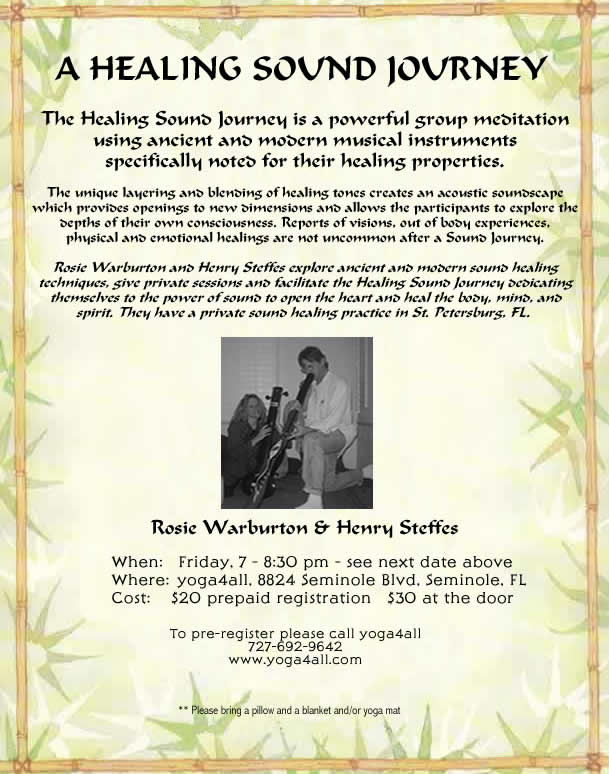
Learn Self-Hypnosis

It’s possible to hypnotize yourself! You can learn self hypnosis quickly and easily in a few simple steps. Self-hypnosis is a natural state of awareness where a person can access their subconscious and give themselves suggestions for personal change. Self-hypnosis can be effectively used for Stress Reduction, Weight Control, Pain Management, Sports Improvement and Better Sleep.
Side Effects? Self-Hypnosis is totally safe. There are no known side effects other than improved health, intuition, memory concentration and sleep.
Why Attend a Self-Hypnosis class? You have a right to a happy, prosperous life. Have you ever heard the average person uses only 10% of their mind? What could you accomplish by learning to use 100% Anyone can learn Self-Hypnosis and reap the benefits. It’s an effective technique you can use for the rest of your life.
Discover How to Take Control of Every Aspect of Your Life. In this self-hypnosis instruction Class you will learn how to:
- Tap into your full potential, how easily it is to enter a hypnotic state
- Use self-hypnosis to recall important information
- Program your subconscious mind for success
Facilitator: Judy Kovatch is a certified hypnotist with the National Guild of Hypnotists. Judy draws from a tradition that is non-dogmatic and open to all. She encourages her students to enter a space of graceful self-inquiry, helping them access their own potential for creativity to achieve total wellness of body, mind and spirit.
TriYoga with Kaliji
